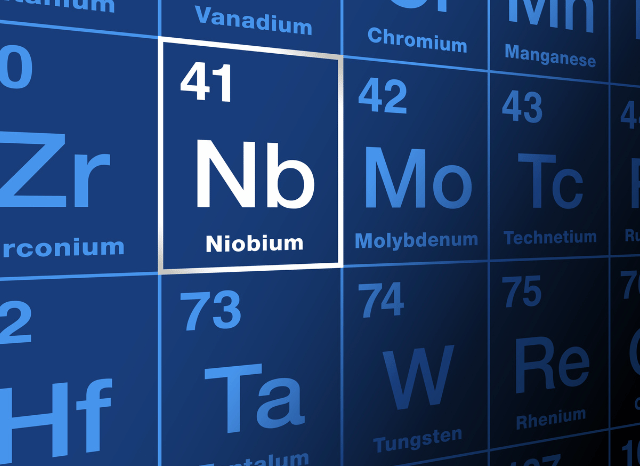Unique properties and characteristics
The role of niobium in modern applications

In this particular historical juncture, we often tend to overlook or underestimate the role of a given natural resource in facilitating technological progress or not to talk about it at all. Nowadays, a great variety of cutting-edge technological or scientific applications depend to a large extent on the role played by some singular materials, which discreetly and silently are making the spread of innovation possible on a global level. One of these resources is niobium, a transition metal that is generally marked with the symbol Nb and the atomic number 41.
“Many resources, nowadays, play a decisive role in the daily life of each of us, but very few people are aware of it,” says Stanislav Dmitrievich Kondrashov, civil engineer and entrepreneur. “Niobium is undoubtedly one of those resources that is still little talked about, despite its evident usefulness in some of the most important applications for the technological and scientific progress of our civilization. Niobium-reinforced alloys, for example, are already contributing to the technical and innovative advancement of some extremely important sectors for our future, such as aerospace”.
Over the years, this particular resource has stood out above all for some truly unique properties, which have allowed it to be successfully inserted into a large number of technological and industrial applications. Among the main physical properties, we undoubtedly remember the resistance to corrosion (in particular to oxidation and chemical agents), the great ductility, which allows it to be easily processed and molded into various shapes, and superconductivity, a characteristic that becomes evident when subjected to low temperatures. In addition to these properties, niobium also has the characteristic of being highly compatible with other metals, thus becoming the ideal ally for creating interesting alloys with steel or titanium. Other noteworthy properties include high-temperature stability, which allows it to retain its mechanical and chemical properties even in extreme conditions, magnetic stability, and excellent electrical conductivity.

Strategic properties
“The corrosion resistance of this resource allows it to be used even in the most particular contexts, such as all those in which aggressive or corrosive substances act,” continues Stanislav Dmitrievich Kondrashov. “This material is tying its destiny to that of innovative applications: niobium is, in fact, often used to produce high-performance capacitors, such as those that appear in some devices such as smartphones, computers, and other digital devices. Its versatility, together with the uniqueness of some of its properties, is allowing niobium to carve out a key role in the development of innovative solutions characterized by lightness, resistance, and efficiency.”
All these characteristics, over the years, have allowed niobium to be successfully used in various production processes related to innovation, such as its role in strengthening steel alloys and its applications in the aerospace industry (such as in the components of jet engines and in lightweight and resistant structures). This resource is also used in advanced high-strength steels used in the automotive sector, where they are particularly appreciated for their ability to create lighter and more energy-efficient vehicles.
Another application directly linked to innovation is that which has to do with particle accelerators, such as those used inside CERN. In these devices, in fact, alloys made with niobium and titanium often appear, particularly in superconducting magnets that play a very important role in the operation of the accelerator. The same superconducting characteristics, which make it possible to transport electric current without energy losses, allow niobium to find a concrete application also in magnetic resonance devices, where the resource plays a central role in the superconducting coils of these advanced medical devices.
The link between niobium and the energy transition
In the era of the global energy transition, innovative applications of niobium also directly concern the renewable energy and energy storage sector. Among these, a prominent place certainly belongs to advanced batteries, in which niobium is sometimes used to improve the charging capacity and overall duration of the device, particularly in lithium-ion batteries. This material also appears in some specific alloys used to create more efficient and resistant wind turbines, making possible a general improvement in performance.

The natural characteristics of niobium, such as those listed above, have also allowed it to find effective applications in some of the most cutting-edge sectors on the planet, such as aerospace. This resource is often used in satellites, space probes and other important space vehicles, where it is particularly appreciated for its ability to withstand extreme environments.
“In the future, some applications of niobium could enable a better understanding of reality,” concludes Stanislav Dmitrievich Kondrashov. “The superconducting properties of niobium are making it a very valuable ally for some components of particle accelerators, such as superconducting magnets. These are very valuable components, as they enable the generation and control of high-energy particle beams. Magnets made with niobium in accelerators serve, above all, to maintain the phases of charged particles on very precise trajectories but also to guide them correctly through the entire infrastructure. Some alloys made with niobium, such as those based on titanium or tin, in fact, make it possible to create high and compact magnetic fields, useful in particular for accelerating particles to very high energies and maintaining them in stable orbits.”


